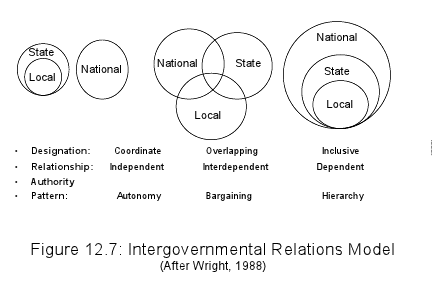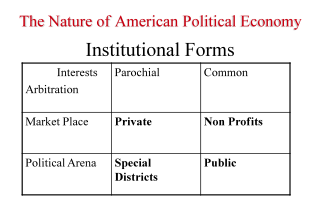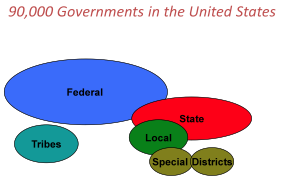Here’s another concept important to the challenges of working in a power shared world.
Concept: Federalism
Federalism is the concept that power is divided vertically among levels of government. It can be expanded to include the horizontal division of power. We then typically talk about it as intergovernmental relations (IGR). In this sense the American constitution can be seen as an “and” document. The Founders had a choice of a strong federal government or strong states. Remember that the Article of Confederation era of American government chose strong states as a principle for organizing. The constitutional convention had as a prime purpose strengthening the union among states. In that process, the framers chose to enshrine both a strong federal government and strong states.
In fact the 10th amendment famously reserves to the states those powers not expressly given to the federal government. The challenge is that many problems that at one time seemed well located at one level of government or another (roads at local levels, fish and wildlife at state levels, international trade at the federal level) no longer seem to have such clear cut boundaries. We have states and large cities engaged in international trade activities. Roads have multiple centers of activity, and fish and wildlife now have both strong state and strong federal policy and administrative presences.

We can think about the relationships among governments as being well layered (affectionately described as a layer cake model) or much less clearly articulated (marble cake). For those working in ENR, it then creates the possibility that professionals with the same training at one level of government, in one agency, may find themselves implementing policy with modestly or strikingly different goals. Obviously for many aspects of such work, the impacts are interwoven on the ground. Federalism is a particular kind of power sharing, but one that still calls for collaborative competency.

Authority structure
Another way to think about federalism can help us understand the structure of authority among governments and the agencies of those governments in the setting in which we do work. In education policy for example, special districts at the local level have had primary responsibility for policy and implementation. Over the last fifty years state and federal governments have gotten more involved in policy making and funding. This has obscured the structure of authority and ensures that many parties will need to be involved to solve problems like this when authority overlaps. In general in forest policy, federal policy applies to federal land and state policy applies to non-federal lands. Here, authority is not overlapping, but because many problems address processes that don’t stop at federal property lines, i.e. fires, watershed, and recreation, we find we have to coordinate activities across these zones of authority.
Finally, in some cases such as in implementing the Clean Air Act, states actually implement federal policy through State Implementation Plans. Here, authority is hierarchical. Even where authority is clearly structured vertically, we often find a need to work together because the issues on the ground in one place are not the same as issues on another. To balance overarching policy goals with local interests we find the need to work together. Understanding the authority structure among public entities doesn’t resolve problems, but can help us understand why we find ourselves in such complex power sharing circumstances.

Paradox of Power:
Another challenge we have with the context in which we solve public problems is that power has two faces. One reason we find ourselves reaching for collaborative approaches is that when power is divided we often find the need to knit it back together to accomplish the goals we share or to solve a common problem.
This can be seen as a paradox of power. Power has many faces. Two at work here are the faces of power over and the power to do work. We typically think of power as being able to get an entity to do what they might not do otherwise – power over. We lodge a particular type of this power in governments where the state can compel behavior of citizens. Driver’s licenses, building permit enforcement, limits on recreational access are all examples of power over. Similarly, the plenary power of the federal government is an example of federal power over states.
Power to do work is a reminder that all organizations, including public organizations, as well as individuals can contribute real resources, real competency, real authority to accomplishing work outcomes. Volunteers planting riparian areas are an example of power to do work. Similarly the authority and resources of the U.S. Army Corps of Engineers to restore stream channels is an example of the power to do work. You can see that in both faces to solve public problems, especially ENR problems at the landscape level, we would need to work collaboratively.




 Discussion: Post a problem you think requires working with others because of one or more of these reasons. This will help you integrate some of these abstract concepts, and all of us to learn more about the problems and contexts you face in your work.
Discussion: Post a problem you think requires working with others because of one or more of these reasons. This will help you integrate some of these abstract concepts, and all of us to learn more about the problems and contexts you face in your work.








